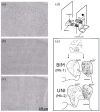Widespread neuronal activity related to bimanual coordination in non-human primates: evidence from Fos-like activation during bimanual versus unimanual motor task
- PMID: 40600237
- PMCID: PMC12209580
- DOI: 10.1177/26331055251352807
Widespread neuronal activity related to bimanual coordination in non-human primates: evidence from Fos-like activation during bimanual versus unimanual motor task
Abstract
Electrophysiological data support the notion that spatial and temporal coordination between the forelimbs in primates takes place in a wide network of cortical and subcortical brain structures. However, single neuron electrophysiology is biased towards large, long distance projecting neurons. The aim of the present study was to assess whether the same neural network is involved when small and medium size neurons are considered. To address this issue, neuronal activity with cellular resolution was investigated and quantified using the c-fos mapping technique, targeting small and medium size diameter neurons, in adult non-human primates. Two male macaque monkeysi were trained to perform a reach and grasp drawer task, executed either bimanually (BIM) or unimanually (UNI). Extensive single unit electrophysiological recordings were conducted in these two monkeys over a two-year period, preceding a final terminal c-fos session during which one monkey (Mk-1) performed exclusively the BIM task, while the second monkey (Mk-2) performed the UNI task only (250 trials each). One additional monkey (control Mk-3) did not perform any task. Fos-like immunoreactivity (FLI) was significantly higher in both Mk-1 and Mk-2 in motor brain areas than in the control monkey, demonstrating that motor activity triggered c-fos. Although the overall muscle activity was roughly comparable in both tasks, Mk-1 (BIM) exhibited a clearly stronger FLI than Mk-2 all along the rostrocaudal axis of the primary, supplementary and cingulate motor cortices, as well as the striatum. In contrast, Mk-1 and Mk-2 displayed a comparable FLI in non-motor regions, such as the visual and auditory thalamus. The present study, a very rare c-fos mapping investigation conducted in macaques performing a complex behavioral task, suggests that small and medium size (local) neurons may also contribute to the specific neural activity responsible for precise interlimb coordination, within a network associating motor cortical areas and the basal ganglia.
Keywords: basal ganglia; bimanual coordination; c-fos; functional neuronal mapping; hand control; macaque monkeys; motor cortical areas; striatum.
© The Author(s) 2025.
Conflict of interest statement
The author(s) declared no potential conflicts of interest with respect to the research, authorship, and/or publication of this article.
Figures




Similar articles
-
Impact of residual disease as a prognostic factor for survival in women with advanced epithelial ovarian cancer after primary surgery.Cochrane Database Syst Rev. 2022 Sep 26;9(9):CD015048. doi: 10.1002/14651858.CD015048.pub2. Cochrane Database Syst Rev. 2022. PMID: 36161421 Free PMC article.
-
Drugs for preventing postoperative nausea and vomiting in adults after general anaesthesia: a network meta-analysis.Cochrane Database Syst Rev. 2020 Oct 19;10(10):CD012859. doi: 10.1002/14651858.CD012859.pub2. Cochrane Database Syst Rev. 2020. PMID: 33075160 Free PMC article.
-
Systemic pharmacological treatments for chronic plaque psoriasis: a network meta-analysis.Cochrane Database Syst Rev. 2021 Apr 19;4(4):CD011535. doi: 10.1002/14651858.CD011535.pub4. Cochrane Database Syst Rev. 2021. Update in: Cochrane Database Syst Rev. 2022 May 23;5:CD011535. doi: 10.1002/14651858.CD011535.pub5. PMID: 33871055 Free PMC article. Updated.
-
Systemic pharmacological treatments for chronic plaque psoriasis: a network meta-analysis.Cochrane Database Syst Rev. 2017 Dec 22;12(12):CD011535. doi: 10.1002/14651858.CD011535.pub2. Cochrane Database Syst Rev. 2017. Update in: Cochrane Database Syst Rev. 2020 Jan 9;1:CD011535. doi: 10.1002/14651858.CD011535.pub3. PMID: 29271481 Free PMC article. Updated.
-
Physical exercise training interventions for children and young adults during and after treatment for childhood cancer.Cochrane Database Syst Rev. 2016 Mar 31;3(3):CD008796. doi: 10.1002/14651858.CD008796.pub3. Cochrane Database Syst Rev. 2016. PMID: 27030386 Free PMC article.
References
-
- Luppino G, Matelli M, Camarda RM, Gallese V, Rizzolatti G. Multiple representations of body movements in mesial area 6 and the adjacent cingulate cortex: an intracortical microstimulation study in the macaque monkey. J Comp Neurol. 1991;311:463-482. - PubMed
-
- Luppino G, Rizzolatti G. The Organization of the frontal motor cortex. News Physiol Sci Int J Physiol Prod Jointly Int Union Physiol Sci Am Physiol Soc. 2000;15:219–224. - PubMed
-
- Dum R, Strick P. Motor areas in the frontal lobe of the primate. Physiol Behav. 2002;77:677–682. - PubMed
-
- Lemon RN. Descending pathways in motor control. Ann Rev Neurosci. 2008;31:195–218. - PubMed
-
- Bufacchi RJ, Battaglia-Mayer A, Iannetti GD, Caminiti R. Cortico-spinal modularity in the parieto-frontal system: a new perspective on action control. Prog Neurobiol. 2023;231,102537:1-39. - PubMed
LinkOut - more resources
Full Text Sources

